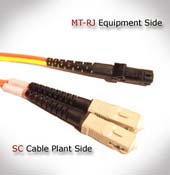
MTRJ to SC Connector Duplex Patch cord
Mode Conditioning Cable Information
Things to know when using mode conditioning cables to patch
an existing multimode cable plant to your Gigabit LX equipment.
1) Mode conditioning cable are normally used in pairs. That means that you will need a MC cable at each end to connect the equipment to the cable plant. So then these cables are usually ordered in even numbers. The usual reason why someone may order one cable is so they may keep it as a spare.
2) If your gigabit LX switch is equipped with SC or LC connectors, please be sure to connect the yellow leg (Single mode) of the cable to the transmit side, and the orange leg (multimode) to the receive side of the equipment. It is imperative that this configuration be maintained on both ends. The swap of transmit and receive can only be done at the cable plant side. (see diagram below)

3) Please see Frequently asked questions below for additional important information Principals and Basics on how a Mode Conditioning Cable works


| Features | Benefits |
|
|
We have created this page to illustrate the very basic differences between 62.5 and 50/125 multimode fiber in selecting a patch cable for your existing cable plant.
The key thing to remember is to always use a patch cable of the same type as the cable that you€™re connecting to. The most common installed fiber today is 62.5/125 by far. It is virtually impossible to tell the difference between the two fiber types (62.5 and 50/125) by looking at the bare fiber or the connectors. Usually, this information will be written on the cables™ jacket.


The photos above illustrate that the outer diameters of the two fiber types are the same. What is different is the size of the center light carrying core of the fiber. You cannot see the fibers’ core without a microscope. Therefore, you must rely on the writing that is on the fibers jacket to determine what type is.
Severe losses of light can occur when you try to match 50/125 and 62.5/125 fiber, as the illustration on the left shows.

NOTE: This page was designed to help you know the difference between 62.5 and 50/125 fiber for the purpose of purchasing patch cables and products to connect to existing installed cabling. This page was not designed to provide information on choosing between the two types fiber for new installations.

Ultra high quality mode conditioning patch cables for Gigabit Ethernet applications is required where Gigabit 1000 Base-LX routers and switches are installed into existing multimode cable plants.
- Environmentally sealed construction
- Insertion Loss: <0.5
- Back reflection (Singlemode end)>50dB
- Optical offset to IEEE 802.5
Frequently Asked Questions
|
Question |
Answer |
|
How do I run Gigabit Ethernet (LX) over my existing multimode fiber optic cable plant? |
Use a Mode Conditioning Cable. |
|
Is there a distance cutoff to where mode conditioning is not required? |
Generally, Mode Conditioning patch cords are required for link distances greater than 984 feet (300 meters). We have heard some case stories where that distance has been lesser or greater. To our experience, the distance of 984 feet (300 meters) is just a benchmark. Your results may vary according to various different equipment and field conditions. |
|
Where can I find an equivalent to the CAB-GELX-625= for my Cisco Gigabit Network Equipment? |
Our 3 meter SC to SC Mode Conditioning patch cable is 100% compatible with the CAB-GELX-625= cable as specified Cisco for their Gigabit equipment, including the Catalyst family. |
|
Do all multimode fiber types require mode conditioning? |
Some manufacturers of the newer "high end" multimode fibers claim that that their premium line cables will not require mode conditioning. Contact the manufacturer of your installed cable for the answer. |
|
When I hold the yellow Singlemode cable up to a light, the light does not come through on the other side. Does this indicate that I have a defective cable? |
The core of the Singlemode cable is so small than it does not gather enough light for it to be visible without a microscope on the other side. this is a normal condition for any Singlemode cable. |
|
Can I use a mode conditioning cable to convert Singlemode to multimode or visa-versa? |
No. Conversions of multimode and Singlemode require Media |

